Last updated: 13 May 2003
|
Last updated: 13 May 2003 |
This page documents Casio digital camera models comments, tips, and photos. Search the site for "casio" for other items about the Casio digital cameras. Contributions welcome.
Jump to the Start of Today's Update (please wait for the page to finish loading).
Subject: Digital Astrophotography with Casio QV4000ex Sent: Tuesday, November 27, 2001 13:13:41 From: postcolonial1@home.com (Mr. Lee) great site. I just started getting into Digital Astrophotography after a long absence from SLR astrophotography. I'd been looking for a camera that would do at least 60 sec exposures. After months of searching, I came across the Casio Qv4000ex; I received it two weeks ago, right before the recent impressive Leonid shower. The camera seems quite suited for beginning astrophotography, but I stress "beginning" because of two factors: (1) an unchangeable ISO 100 setting; (2) and the mysterious 'bulb' setting, which purportedly will allow you to do more than 60 sec exposures only if you have the the remote shutter release which no US vendor (as of this writing) carries. (I'm still waiting to hear back from Casio for a definitive answer to this query.) I have pics from that night at: http://www.pbase.com/postcolonial1 (You might need to turn up the brightness of your monitor a little.) Two other 'critical comments' about the Casio Qv4000ex: (1) When it takes a long exposure, for example 30 seconds, the camera has to do a dark-frame subtraction which ties up the camera for at least another 40+ sec; and if you're using the highest TIFF resolution, it takes up to ten seconds to write the 11 MB image onto the CompactFlash card. Which in turn means you need at least a 128 MB CompactFlash card; and (2) Though the camera seems to have very good noise reduction/dark-frame subtraction subroutines built-in, the digital zoom (on longer 30+ sec exp) creates some very funky red "hoofmark" artifacts on the images. You might have to increase the contrast to notice these artifacts. But otherwise, in general, I'm pleased with the astrophoto potential of this camera. I'm waiting for another clear night (might be a long wait here in Washington State) and I'm thinking of purchasing a 1.7x telephoto adapter to be used with the optical 3x built-in zoom for a better, less noiser zoomed image. Plus, I need to spend a little more time aligning the scope... on some pics near the horizon I got some slight trailing...wish I had an autostar and SBIG autoguider. :) Hope this helps gives some other future digital Meade amateurs some perspective on the viability of using a digital camera. Regards, Kwang
Subject: Orion nebula Sent: Tuesday, January 1, 2002 20:28:24 From: vincent_ysc1@yahoo.com (chan sing) attach photos was used Casio QV-3500 digital camera,60sec expose,ISO 300,70mm home made refractor+40mm eyepiece,mount on ETX90EC,polar tracking.6 frame stack.photoshop enhance. Thanks you. Best regards Vincent
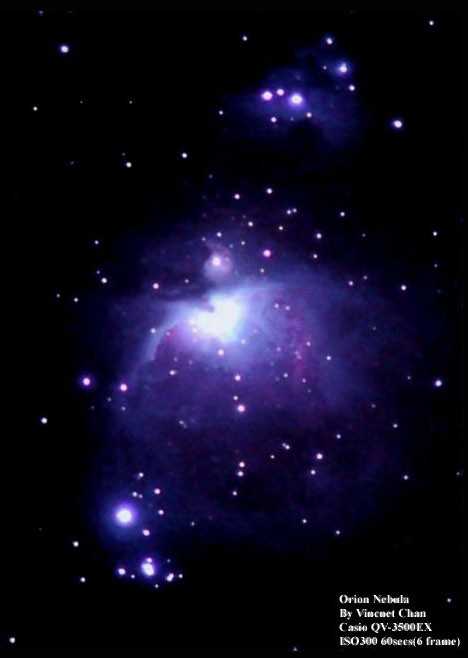
Subject: ETX & 3500EX Sent: Sunday, January 27, 2002 5:21:02 From: yoshi@galaxies.jp (Yoshi-K) ETX-90EX was combined with QV-3500EX. www.yk.rim.or.jp/~ykida/etx/qv.html (Japanese) -------------------------------- Yoshikatsu Kida http://galaxies.jp/ http://www.yk.rim.or.jp/~ykida/etx/
Subject: 1st good shot of Jupiter Sent: Monday, February 4, 2002 20:57:26 From: ETX_Astro_Boy@SBCGlobal.net (ETX_Astro_Boy) I finally get a chance to try some shots with my ETX-105 and my Casio QV-3500ex Digital Camera. The shot I'm attaching for possible inclusion in your Gallery is a stack of 3 shots sharpend up a little and cropped. The shots were taken with the camera mounted afocally using the Scopetronix Digi-T system and the Casio LU-35 Lens adapter. The EP was a Celestron 40mm Nexstar Plossl with a Celestron 2x barlow. The exposures were 1/10 sec @ F4. Craig
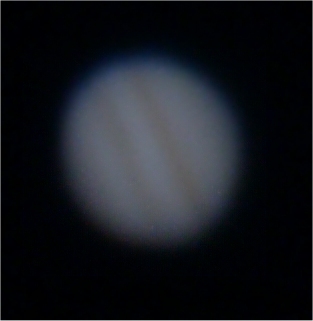
Subject: Jupiter's moons with an etx 105 and Casio qv3500 Sent: Friday, April 12, 2002 11:06:00 From: mjcripps@ukonline.co.uk (mjcripps) I thought people may like to see what can be achieved at the first attempt with an etx 105 and a Casio qv3500 camera combination. From left to right there is Europa, Jupiter, Ganymede, and Io. The conditions were far less than ideal with a stiff wind, a lot of cloud and a sodium street lamp a couple of yards away. I gave up using a parfocal support and hand held the camera to a 9mm Vixen lanthanum. I grabbed the shot when Jupiter managed to shine through a thinner bit of cloud. The camera recorded a comprehensive set of data including- 4/11/02 9:56 pm (GMT +1),F2, 1/2 sec, ISO 500. There has been no enhancement, only cropping. Of course it may be blind luck and I'll never record anything else! Regards Mike Cripps
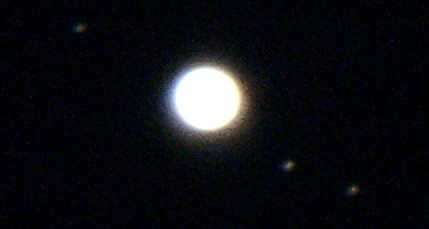
Subject: The eagle has landed! Sent: Sunday, April 21, 2002 13:49:38 From: mjcripps@ukonline.co.uk (mjcripps) After the initial success of grabbing Jupiter's moons with my etx 105 and casio qv 3500 I've been struggling to get some more shots. Friday the 19th gave a crystal clear night here in Norfolk, England and as you recommend I attacked the crescent Moon. Focusing proves to be the most difficult thing to master on such a tiny screen. I got some nice shots. The one I attach was handheld to a 9mm Vixen Lanthanum, manual focus and exposure, iso 500, 1/60s, f2. I've been addicted to Apollo since 11 landed on my 10th birthday, so I was keen to find the landing site. The original image (reduced here to 90k from 1200k- but with no enhancement) appears to show features down to about 10km across. I think Tranquillity base is across from the 1 of the 19, near to where the lighter grey starts. Regards, Mike Cripps
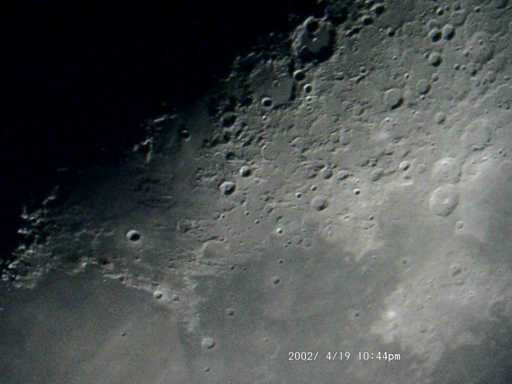
Subject: A link to my Astro Photo Pages Sent: Monday, February 10, 2003 13:30:50 From: ETX_Astro_Boy@sbcglobal.net (Craig M . Bobchin) I'm sending you a link to a new page of Astro Photos I've been putting together. All of these were taken with a CASIO QV-3500EX via eyepiece projection. Most were taken through either my ETX-105 UHTC, or my Club's 12" LX200. There are a couple of shots that were taken through the Club's 22" Kuhn scope. Enjoy. They are not the best, but hey at least they show something. http://photos.yahoo.com/craigbobchin@sbcglobal.net Craig
Mike here: This past week I received a Casio Exilim EX-S2 digital camera. Although I have a Nikon Coolpix 995 which I use for all my general photography AND astrophotography, I decided I wanted a compact digital camera that was small and easy to carry around but yet would provide nice photos. The 2 mega-pixel Casio Exilim fits the bill perfectly. It is very small, as you can see in this photo:
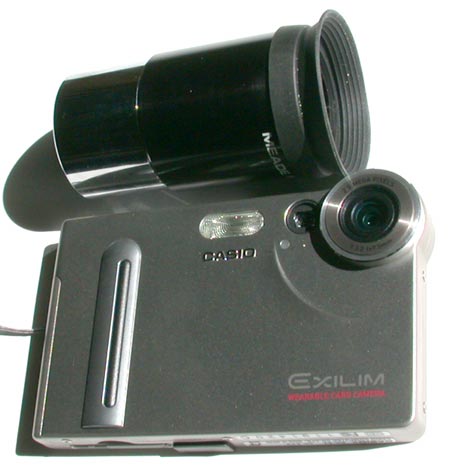
I held the camera lens up to the 25mm eyepiece on my ETX-70AT and took this shot of the Moon:
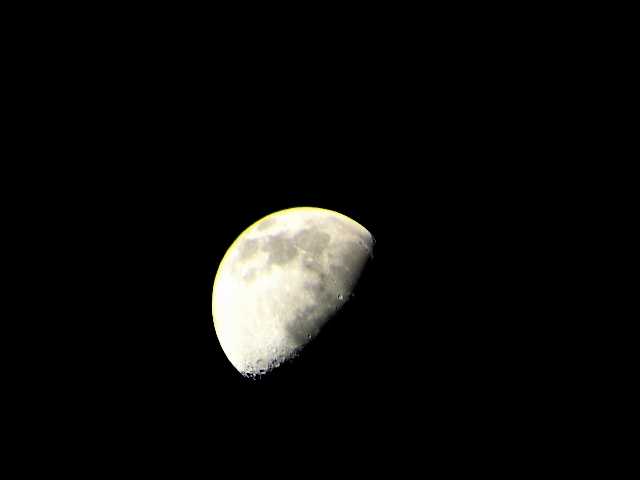
Not too bad considering it was handheld.
I then held the camera up to the 26mm eyepiece on my LXD55 8"SC and took this photograph of Saturn:

Considering the minimal magnification used on the LXD55, it is amazing that you can see the Ring in this handheld photograph!
These photographs show that almost any digital camera can be used to take photographs of brighter astronomical objects.
The Exilim comes with a rechargeable battery, a USB/recharging cradle, a built-in 12MB storage but can also accept SecureDigital and MMC memory cards, and a CD-ROM with Windows and Mac OS software. With some newer OSes, no extra software may be needed; with Mac OS X 10.2 I did not need to install anything and iPhoto 2.0 immediately recognized the Exilim when placed into the cradle and imported its photographs. The price for the Exilim starts at $280.
Return to the top of this page.
Go back to the Astrophotography Page.
Go back to my ETX Home Page.